The Way It Is/ Creating a new paradigm or tilting at windmills?
by Gordon Kirby By now you've no doubt read all the details about IndyCar's made-in-America Dallara Indy car for 2012. IndyCar hopes to convince its teams and other car builders or engine manufacturers to create partnerships to build their own aero kits--front wings, sidepods, engine cover and rear wing. These aero kits can be sold to any team for no more than $70,000. Meanwhile, Dallara will begin building a manufacturing facility in downtown Speedway, Indiana close to the Indianapolis Motor Speedway aided by a $5 million state subsidy and tax breaks from the state and local governments.
By now you've no doubt read all the details about IndyCar's made-in-America Dallara Indy car for 2012. IndyCar hopes to convince its teams and other car builders or engine manufacturers to create partnerships to build their own aero kits--front wings, sidepods, engine cover and rear wing. These aero kits can be sold to any team for no more than $70,000. Meanwhile, Dallara will begin building a manufacturing facility in downtown Speedway, Indiana close to the Indianapolis Motor Speedway aided by a $5 million state subsidy and tax breaks from the state and local governments.
Many fans are disappointed that competing car builders are permitted to build only aero kits for 2012 and that Dallara will continue to form the core of Indy car racing for at least the next five years if not many more to come. And too, many fans are disappointed to see the exciting Delta Wing concept rejected by IndyCar.
"A simple solution wasn't going to cut it," commented IndyCar team owner Gil de Ferran a member of the seven-man 'Iconic' committee. "The cheapest solution wasn't the right solution and a solution that was right from the perspective of technology and innovation wasn't right from any other perspective."
De Ferran said IndyCar hopes to embrace multiple car builders in the future.
"There was certainly a lot of discussion on that front," Gil said. "We were looking at this decision not only for the short term from 2012-15, but essentially laying the groundwork for the longterm future of the series.
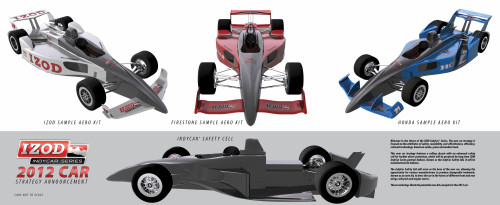
© IZOD
Delta Wing designer Ben Bowlby could not hide his unhappiness about IndyCar's decision to go with Dallara for 2012-15.
"We're deeply and bitterly disappointed in the decision," Bowlby remarked immediately after the announcement. "An enormous amount of work has gone into the Delta Wing with a lot of people working their hearts out to put together a really credible option for the future and I believe the Delta Wing was still the option that was environmentally correct.
"Chip (Ganassi) put the Delta Wing concept together to get the process moving and we certainly did that. We achieved that. We also wanted to get the costs down and we achieved that too. We also wanted to get the cars built here in Indianapolis. That was our plan."
Bowlby believes the Delta Wing will surface elsewhere in racing.
"I think the concept is too good to put aside," he observed. "The genie is out of the bottle and we feel it has the environmental relevance and auto industry relevance, not just in lip service but in reality. We will regroup and work out how we get the car on the race track. We'll have to work out what the investors in Delta Wing want to do."
Delta Wing CEO Dan Partel said when IndyCar announced its 2012 engine rules early in June he believed the Delta Wing project was history.
"I knew when the V-6 engine was announced that we had been zapped," Partel observed. "Our simulations say with 700 hp we would do 300 mph plus."
Partel and Bowlby had proposed to IndyCar a parallel development program for the Delta Wing.
"They could have had their cake and eat it too," Partel commented. "We offered them a parallel development program to run the Delta Wing. We proposed that they work with us to run the Delta Wing as a development program through 2013 giving us time to also allow the automobile manufacturers to develop their engines and a relationship with IndyCar.
"They could have done the Dallara deal as is without any problem and kept the Delta Wing as a development series. You could have kept the buzz and the interest going and found a way to introduce new engine manufacturers for a new concept of a much more efficient car. Now, with the same car and engine combination, what have they got for buzz?"
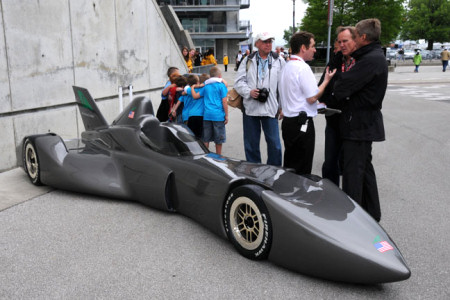
© Paul Webb/LAT USA
"All five of us were within $5,000 on the price of our chassis," he observed. "We came in at $385,000, Dallara is at $384,000 and Lola, Swift and BAT were in the same ballpark."
Partel hopes to keep the Delta Wing project alive.
"I will prepare a set of options for Chip," Partel said. "But I'm afraid investor fatigue has got to be there. I'm doing everything I can to try to keep the staff together. At this point it's out of Chip's largesse. We have an extremely fine team of engineers who've devoted their time, energy and lives to this project. It'll be tragic if we have to let them go. I think this was a brilliant opportunity that's been thrown away."
Partel said the cost of developing the proposed aero kits will quickly run into millions of dollars.
"Do you have any idea what the costs are in doing an aero kit?" he mused. "First of all, it takes a quarter of a million dollars to build a wind tunnel model. Then the Windshear rolling road tunnel in North Carolina costs $32,000 a day and I think it's $20,000 a day for the Reynard tunnel in Indianapolis. So it's going to add up very quickly to many millions of dollars."
Roger Penske uses his North Carolina wind tunnel full-time for his NASCAR and Indy car teams. Penske had hoped to lease time in the tunnel but none is available, so you can imagine how much time, effort and money Penske will put into developing his own superior aero kit. But Partel believes the announced cost reductions will result in similar cuts in sponsorship income.
"I think they've made a tremendous blunder by saying they've cut the costs by 45 percent," Partel commented. "Any sponsor is going to say that if the costs are that much cheaper then they're going to cut their sponsorship budget by an equal amount. That's something Bernie Ecclestone would never have done. He understands that you've got to push the value up, not decrease it."
Indeed at Long Beach back in 1980 Mo Nunn convinced the local Budweiser distributor to sponsor his Ensign team for the weekend for $50,000. Ecclestone got wind of the deal and took Nunn aside to give him a short but stern lecture.
"You bloody fool Mo," Ecclestone growled. "You've undersold yourself and undersold the rest of us too. Don't ever do this again. If you need some leverage to jack up the price call me and I'll help you out. But don't ever sell yourself cheap like this. You're hurting all of us."
Partel also said the drivers quoted in this space last week asking for more power should start thinking more deeply about what's required from the sport in this day and age.
"It offends me as an American, counting the war dead week in and week out, to see the drivers clamoring for unnecessary power when they should be talking power-to-weight ratios," Partel remarked. "Frankly, I think the drivers should come to a realization that when they're clamoring for power they're going against the United States government and what the President of the United States has requested that we reduce our consumption of energy.
"It's very offensive to hear the drivers clamoring for more power when they should be asking for a better power-to-weight ratio and much better efficiency overall. They're making a lot of money off this country, its economy and the American racing community, and they have to start to understand that they have a social responsibility as race car drivers.
"Just wanting to have more power is bullshit," Partel added. "These are nice guys. I'm not trying to break their tails. But they need to smarten up about what's going on in the world today."
Partel complimented Ganassi for his forward-thinking and attempt to construct a new paradigm for Indy car racing.
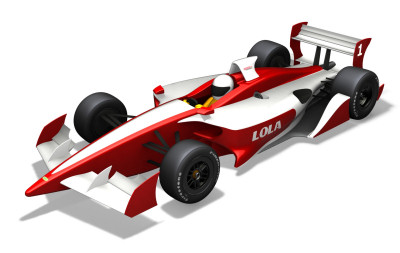
© Lola Cars
Lola's owner and chairman Martin Birrane is as disappointed with last week's decision as Bowlby and Partel. Birrane is a longtime racer with tremendous passion for the sport. He's also a true gentleman.
"I congratulate Dallara for meeting their goal and the IRL committee who met their goal too," Birrane said. "There are no hard feelings at all. We tilted at doing the chassis, but both Dallara and the committee achieved their goals. For whatever reason, Dallara are the blue-eyed boys.
"We did spend a lot of time and effort on making a presentation in the hope that those seven wise men just might closely observe our ideas and capabilities," Birrane added. "I was suspicious from the beginning that we had a chance, but there was hope that they would want something more exciting rather than more of the same. The IndyCar series requires competition. It requires something really different and I don't think they're on the right track here."
Birrane hopes Lola will be able to build and sell aero kits for 2012, but said he can't make a formal commitment until he better understands the aero kit economics.
"We are interested in doing aero kits to help spice things up a bit," Birrane commented. "So if it makes sense we will build an aero kit. We are racers and we will enter into the competition. I'm an old race fan. I love American open-wheel racing. I love NASCAR, I love V-8s and I love all of American racing. I'm an old racer and as long as I'm around Lola will participate in any form of racing that makes sense to us. We're into competition.
"I would hope that Dallara will give out the basic data about the car and not try to hold everything back so that nobody else can compete. If we were in that position we would give our competitors a fair crack and want to compete with them."
Birrane added that IndyCar's rumored $200,000 licence or registration fee for aero kit builders might dissuade Lola from entering the game.
"If that's true they're sending us another message," Birrane said. "That's tilting the table where they don't want competition."
Lola Car's North Carolina-based American manager Steve Charsley expanded on Birrane's observations regarding aero kits.
"We'll take a view on that sometime soon," Charlsey said. "We need to see more details. I wouldn't count us in or out. Right now, I don't think we've really got a feeling on it. It would be called a Lola, which would be good, but the downside is it's going to be very expensive to make a competitive kit.
"If you're going to get into it you've got to do it full-bore. If you do it half-baked you're going to have an aero kit that's inferior. So we've got to evaluate what the value is in us putting $5 million into an aero program to develop a kit. I'd like to think were going to do it with somebody in some type of partnership."
Charsley believes that only one successful aero kit will emerge for each of IndyCar's two applications.
"I think in the next two or three years after running this thing for a little while there will only be two kits," he commented. "There will be a high downforce kit for the street and road courses and a speedway kit for the ovals. Whoever comes up with the best job will win the entire market. It's the history of racing. Someone gets it right and someone else doesn't."
Charsley said Lola equalled everything Dallara proposed to IndyCar as reported in this space more than two months ago on May 3rd.
"Our June 4th presentation covered 195 pages including a plan to build a 40,000-50,000 square foot facility in the town of Speedway, right across the road from the track," Charsley recounted. "Our idea was to employ twelve to fifteen people fulltime and use the cottage industry of the shops in Indy to build pieces and components. For example, we would have used maybe Mark Scott to build the wishbones and Jackie Howerton to build the exhausts. And with a four or five-year agreement these people would have been able to rebuild their businesses.
"We were prepared to build a big factory with the simulators and fan experience showplace that Dallara are talking about. In our presentation we committed to a $6 million simulator plus the cafe and destination place for fans to bring the fans in and be close to the Speedway. Our presentation proposed that we do that right there in Speedway, Indiana, no different to Dallara."
Charsley said he still believes the spec car-based concept is the wrong direction for the sport.
"It survived all those many decades through the 20th century with just a rule book," he observed. "Here's the rules guys they said. Come on and build your cars. People want to see quality. That's what's always driven the sport. But now, we seem to be going Kmart and Wal-Mart racing instead of Bloomingdale's.
"From day one, racing has always been expensive. It was always for the wealthy people. The wealthy survived and the poor got used up and tossed out because it isn't a poor man's sport. Today, you look at a baseball player signing a $50 million contract, or a basketball player signing an $80 million contract. But we're talking about the state of Indiana giving $5 million to Dallara and rebates on car sales to Indiana teams. So again, are we now going after the Wal-Mart customers rather than the Bloomingdale shoppers? I guess we are."
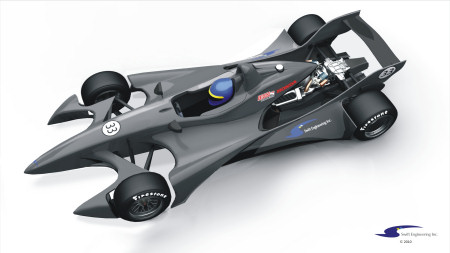
© Swift Engineering
"Ben totally believes in the Delta Wing and that's great," Charsley said. "He put something out there that was really bold and got all of us thinking."
Meanwhile, Swift Engineering's president Jan Refsdal was as surprised as anyone with last Wednesday's annnouncement.
"It's a disappointment to Swift Engineering, of course," Refsdal said. "But we wish everybody the best of luck and good fortune. I had expected them to announce it was going to be some type of limited, open competition between multiple chassis manufacturers. The whole thing came as quite a surprise. I think Randy Bernard is going to have some salesmanship to do with the fans and the stakeholders with the same old Dallara-Honda combination.
"We were doubtful that we had a chance when we heard they weren't going to announce a selection until July 14th and nobody knew anything about what was going to happen. I can't imagine IndyCar entering into a deal with anyone without having some limited discussions about how the deal was going to work before they made the announcement."
Swift's proposal was detailed in this space on May 17th.
"I think Swift certainly put forth a great proposal," Refsdal commented. "I think from a dollar standpoint we were more competitive than the numbers I've seen so far and it would have been produced in the United States using Indy labor. As you know, we had a strategy to employ the composite facility in Indianapolis as well as suppliers that have over two hundred employees. So I think, to some extent at least, we had checked the made-in-Indianapolis box. But maybe this deal was done before the RFP process began."
Swift, like Lola, hopes to build an aero kit for the 2012 formula.
"I can't make a comment at this stage because we haven't had the opportunity yet to understand what the deal is," Refsdal said. "We'll meet this week and take a look at it. I think it's an interesting idea and it will be interesting to see how things work out.
"I'd love to see open competition where all of us could put our chassis out there and the best man would win," he added. "I was hoping they would decide that they would write the rules and you guys can show up and compete. But in that situation there would have to be fair market value on the price of a chassis because one has to invest an awful lot of money to get to the point where you have a competitive car."
Former Lola and Reynard designer Bruce Ashmore is a believer in the aero kit concept. Ashmore says he thinks his company, Ashmore Design, will produce an aero kit.
"I think you'll see several people do it," Ashmore commented. "This is an idea we have talked about several times and I'm really pleased that the 'Iconic' board and IndyCar have decided to embrace it and go for it.
"The outside shell is what everybody sees," he continued. "When we designed and built new cars each year at Lola and Reynard you had to design a whole car to get a different look. There's quite a lot of innovation and development that goes on with the current Dallara every year, but it's all in areas that you can't see--suspension and upright changes and wheel bearing seals. It's all a complete waste of money because the race fan can't see it.
"So the 'Iconic' board have turned it around so that all the bits on the inside are now spec components. But the bits on the outside can be developed so you could have very different cars. They've allowed us to build a body kit so you can run your big, expensive components for four years. Companies like Ashmore Design, Lola and Swift can come along and get involved. They've limited our risk and given us an opportunity to build a new kit every year.
"I doubt that BAT would do it," Ashmore added, "because to form a new entity like BAT to recoup the investors and partners we had you need to build a whole car. But for a little company like Ashmore Design it's definitely something we could do. I think it's highly likely that Ashmore Design will be involved."
Ashmore emphasized that it will be more expensive than many people think to produce a successful aero kit.
"It's not a cheap solution," Ashmore said. "This idea will cost the teams money going forward. If you buy the wrong kit and get beaten at the Indy 500 you'll want to buy the kit that won Indy in time for Texas. So it will cost money, but it will also create a story and the next year it will start all over again. So again, it won't be cheap, but it's limited the investment.
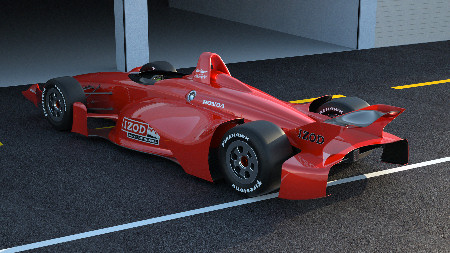
© BAT Motorsport Engineering
Randy Bernard admits it will take a year or two to attract new engine manufacturers other than Honda and aero kit builders.
"I think we have to be realistic and not set our expectations too high," Bernard said. "Our goal was to be looking at the longterm and we knew that engine and chassis manufacturers were under deadlines right now to get moving. So we think it's going to be pretty darn hard to see other engine manufacturers by 2012. We're optimistic and our goal is to have some interest from other engine manufacturers and aero manufacturers in 2013 for sure."
Bernard plans to travel to Europe in August with Brian Barnhart, Tony Cotman and Gil de Ferran to meet with a series of European engine manufacturers.
"The auto manufacturers that we have discussed this with have said that it's very exciting that they can create brand identity with their cars," Bernard remarked. "But we haven't been able to talk to everyone because we wanted to keep as much of this as confidential as possible. So we were very selective in our first round of talks with the engine manufacturers. Now we're ready to visit each of them and provide a detailed proposal of our formula and plans."
One of Bernard's next steps is to hire an experienced racing engineer to lead his technical department and write the rules for 2012.
"We have to make sure that we put one person in charge of overseeing both the engine strategy and the chassis strategy and bring it all together," Bernard commented. "That person is going to have to be brilliant. He's going to have to be aggressive and a guy who thinks offensively and not defensively. It's going to be an important and significant process for us."
Bruce Ashmore is lobbying for the job of overseeing IndyCar's expanded and improved technical department.
"For this to be a success, IndyCar will need to roll the information out in a timely fashion for companies to get involved," Ashmore observed. "Then there's the policing of the components. In order to keep close competition you will need to have a very strong technical base at IndyCar to get the potential out of these rules.
"I'd like to be the guy organizing the rules," Ashmore added. "I think this is going to be quite an exciting period of time and I would love to be involved in helping with writing the rules and policing the rules and policing all the different manufacturers that could come into the series. If it's organized correctly I think we have the potential of bringing in some fairly big names. I think it's possible to get Ford, Boeing and Lockheed--all of which were mentioned in the 'Iconic' board's presentation--into the series and I would love to be involved in that process."
It will be intriguing to see how many aero kit builders make commitments to IndyCar over the next few months. Equally, we will watch with great interest to see if Randy Bernard can begin to build some serious interest in Indy car racing among the world's automobile manufacturers.
Auto Racing ~ Gordon Kirby
Copyright 2010 ~ All Rights Reserved
Copyright 2010 ~ All Rights Reserved
Top of Page